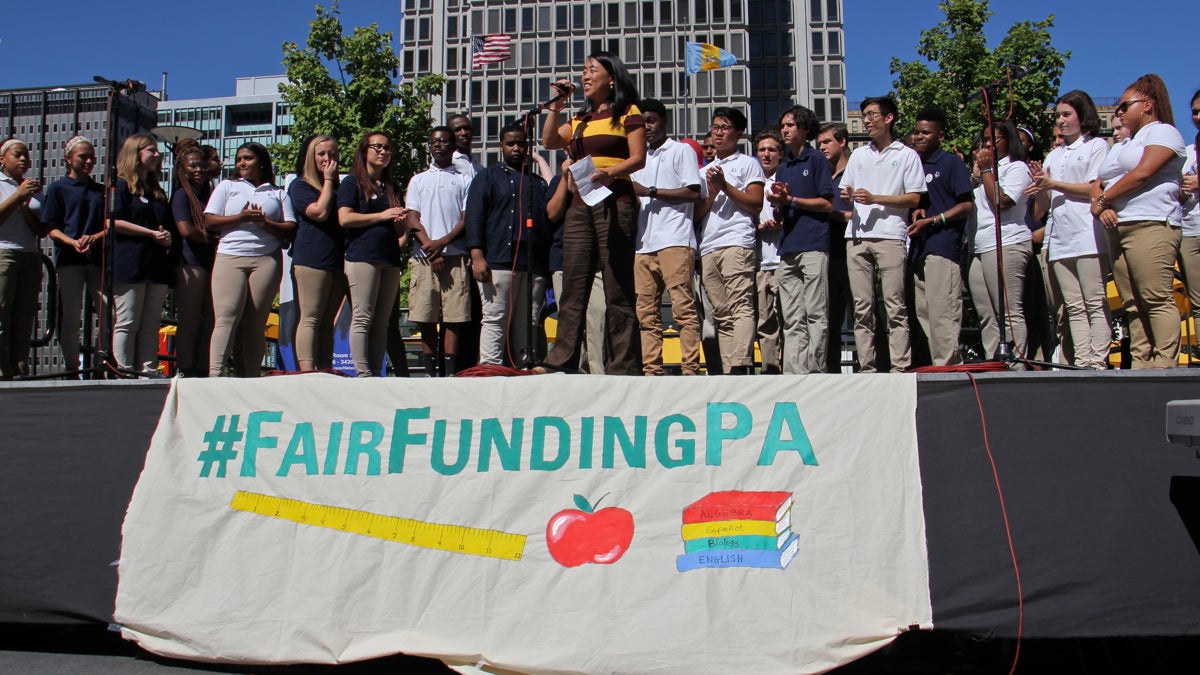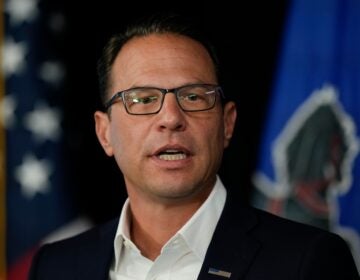Pennsylvania’s education funding case: Here’s what you need to know
Listen
Philadelphia City Councilwoman Helen Gym takes the stage with the Girard Academic Music Program singers at Dilworth Park
A word of warning: This story will be venturing into the weeds.
But bear with us. Because the outcome of the lawsuit described below could determine a lot of things that you probably care about — including your local tax rate, whether your kids get new textbooks, or whether they get textbooks at all.
All of this comes down to how the state of Pennsylvania funds education. And that system is facing a big challenge right now in court.
On Tuesday, the State Supreme Court will hear oral arguments in the case of William Penn School District versus the Pennsylvania Department of Education.
This case will not determine whether Pennsylvania’s educational funding scheme violates the state Constitution. Instead, it will determine whether the state courts are a suitable place to hash out this disagreement over education funding.
Twice before the state courts have denied this type of claim. They’ve essentially said education funding is the Legislature’s job — leave us out of it.
But the plaintiffs this time around think they’ve got an edge that their predecessors didn’t.
Meet the plaintiffs
The plaintiffs in this case are a coalition of Pennsylvania school districts, advocacy groups, and students. The common denominator is that all feel shortchanged by the state’s system for funding education, a system that relies heavily on local tax dollars.
They argue that this funding scheme creates gross disparities between the haves and the have nots — the wealthy districts of the state and the poor ones. They cite a recent study from the U.S. Department of Education that found Pennsylvania had the largest per-pupil spending gap between “poor school districts and affluent districts.”
They argue that this inequitable funding system violates the law in two ways.
It violates equal protection guarantees in the Pennsylvania Constitution.
It violates the education clause in the Pennsylvania Constitution. That clause is a single sentence and reads: “The General Assembly shall provide for the maintenance and support of a thorough and efficient system of public education to serve the needs of the Commonwealth.”
In their petition, the plaintiffs claim the “availability of a basic education in Pennsylvania is now a function of community wealth rather than a constitutional guarantee.” And that, they argue, is a direct violation of the state constitution.
Meet the defendants
On the other side of the ledger are government entities and politicians. They are Gov. Tom Wolf; President Pro Tempore of the Pennsylvania Senate Joseph Scarnati; Speaker of the Pennsylvania House of Representatives Mike Turzai; Secretary of Education Pedro Rivera; the Pennsylvania State Board of Education; and the Pennsylvania Department of Education.
Their argument isn’t concerned with the relative inequity of Pennsylvania’s system for funding schools. Consider this key sentence from a reply brief submitted on behalf of the Pennsylvania General Assembly:
“Although the Petition is lengthy and contains copious detail about the alleged educational imbalances resulting from Pennsylvania’s system for funding education, the vast majority of this detail is not necessary for this Court to resolve the instant appeal.”
The defendants instead focus on whether the court is even allowed to consider a case like this.
Their answer? An unequivocal “no.”
They basically say the courts aren’t supposed to wade into public policy debates. Again from the brief:
“In short, Appellants seek a judicial remedy for a multi-faceted problem that courts, by their very nature, are not equipped to address.”
Judges! What are they good for?
Basically all this comes down to whether education funding is a “justiciable” issue in Pennsylvania. That’s lawyer speak for a pretty basic question: Should judges get involved?
Of course, our government — both at the federal and state level — is based on separation of powers. Judges are responsible for interpreting law and determining whether people are adhering to that law. Legislators craft the law. Executives enforce it.
In the 1960s, the U.S. Supreme Court heard a case called Baker v. Carr. The court’s decision in Baker created a roadmap for determining when judges should get involved in questions that could be considered outside their realm.
Baker laid out six tell-tale signs of cases that would considered too “political” for a judge to touch. One of them is crucial here. It says the courts shouldn’t rule on something if there is “a lack of judicially discoverable and manageable standards for resolving it.”
Now Baker is just a set of guidelines. Several state-level judges have looked at Baker and said it doesn’t prevent them from ruling on education funding issues. Judges in Massachusetts, New Jersey, California and Connecticut have all intervened in education funding questions and prodded their respective legislatures to action.
So far, Pennsylvania judges have been reluctant to even dip a toe in the education funding pool.
Deja sue
Twice before, Pennsylvania judges have confronted challenges to the state’s education funding scheme. In both cases, the judges decided the issue was not “justiciable.”
The first case, Danson v. Casey, took place in the late 1970s. In Danson, the School District of Philadelphia sued the state because its relative lack of resources required the district to offer a “uniquely limited program of educational services.” The court wasn’t swayed, in part because Philadelphia at the time was the fifth-highest-funded district in the state.
About two decades later, in 1999, a case more similar to the present one came before the court. In Marrero v. Commonwealth, the plaintiffs argued that the state Legislature hadn’t provided for the “maintenance and support of a thorough and efficient system of public education” as the state constitution requires.
Again, the judiciary decided not to involve itself.
The defendants highlight these cases clearly in their briefs. Lawyers for the General Assembly wrote:
“This Court has already rejected nearly identical challenges on two separate occasions, expressly holding in Marrero that the method chosen by the General Assembly to finance public schools presents a nonjusticiable political question.”
If at first you don’t succeed …
The plaintiffs aren’t arguing that the Pennsylvania Supreme Court erred in Danson or Marrero. Instead, they’re saying the judges didn’t have the tools necessary back then to safely navigate the education funding debate. But there are have been three big changes since then:
The state has revised its academic standards, providing a far clearer threshold for what it considers an adequate education.
The state has since developed a suite of tests to objectively measure whether students are meeting those standards.
In 2007, the state released a study to show how much money would be required for students to meet those standards.
The plaintiffs argue these developments provide a clear standard for adequacy and ways to measure whether the state has met the standard. If they can get to the next phase of the case, the plaintiffs would eventually argue that the state’s funding system prevents students from meeting the established standards.
Right now, though, the plaintiffs are merely arguing that these standards give the judges a safe route into this conversation. In other words, there are now “judicially discoverable and manageable standards” for resolving the matter.
“We are not asking the court to substitute its judgment for the Legislature’s,” said Michael Churchill, an attorney from the Public Interest Law Center who is also one of the lawyers for the plaintiffs. “Our claim is that there’s no policy decision required at this point.”
Many of the same public education advocates backing this lawsuit are deeply skeptical of the state’s revised standards and its ever-evolving batches of standardized tests. Those skeptics include the Philadelphia Federation of Teachers and Parents United for Public Education, which each wrote briefs supporting the plaintiffs. Those parties will have to swallow their objections for the moment, however, since the lawsuit rests on the assumption that these standards and tests provide a true and meaningful measure of how much students know.
A lone Wolf
One traditional ally of public education spending won’t be siding with the plaintiffs: Pennsylvania Gov. Tom Wolf.
This suit was originally brought against former Gov. Tom Corbett. Since then, Wolf has become Pennsylvania’s chief executive and lobbied for big increases in state aid to education. That hasn’t, however, warmed him to the plaintiffs’ position.
Instead he has argued — forcefully and publicly — that the judiciary shouldn’t inject itself into the education funding debate. That aligns him with the very General Assembly Republicans he has often battled with for extra education funding. Wolf, however, says it’s a matter of governmental prerogative and principle.
“This particular matter is about whether or not the court should be deciding how much funding should go to schools, and we don’t believe that it should,” said Wolf spokesman Jeff Sheridan. “The governor and the General Assembly should be deciding that, and the governor is going to continue to ask for more funding.”
Wolf — who filed a separate brief from the General Assembly and retained his own counsel — has pointed to the recent passage of a new fair funding formula as evidence that the lawsuit is unnecessary. He and the General Assembly have also underscored that there were state standards and tests during the time when Marrero was decided, albeit different ones.
But what about all the other states?
The case before the Pennsylvania Supreme Court is exclusively about the interpretation and application of Pennsylvania law. Education funding decisions in other states have no direct legal bearing on the case.
Of course, no lawsuit happens in a vacuum, and both sides point to other states where education funding cases have wound up in the courts. The plaintiffs point to states — Massachusetts, in particular — where the courts have intervened successfully. The defendants point to others — New Jersey, for instance — where courts have gotten trapped in a cycle of complicated decisions.
“What we’ve found is in a lot of the states where judges have tried to get involved in more of an activist way, it’s created a big mess,” said Patrick Northen, one of the attorneys representing the General Assembly.
The plaintiffs are trying to say to the judges, “Look, it can be done.”
The defendants response: “Tread lightly.”
So what happens next?
Commonwealth Court has already ruled against the plaintiffs in a unanimous decision.
If the Supreme Court reverses that decision, the case will go to a full trial where the justices will have to determine the merits of the plaintiffs’ claims. If the Supreme Court upholds the lower court decision, the case ends. So too does the possibility of a legitimate legal challenge to Pennsylvania education funding system — at least in the near future.
There is a third possibility. The high court could say that the equal protection claim is justiciable, but not the education clause claim. The reverse is also possible.
If either of those scenarios were to play out, the case would still move forward to a full trial.
WHYY is your source for fact-based, in-depth journalism and information. As a nonprofit organization, we rely on financial support from readers like you. Please give today.





